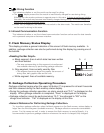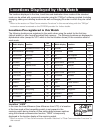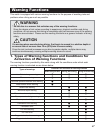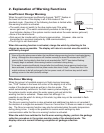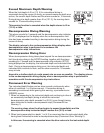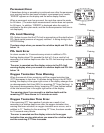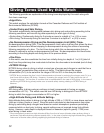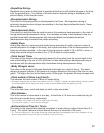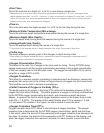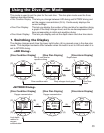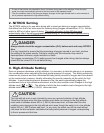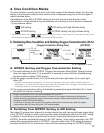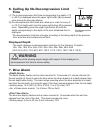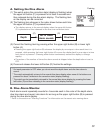
52
The following provides an explanation of the diving terms displayed by this watch along with
their basic meanings.
<Algorithm>
This watch employs the calculation formula of the Canadian Defense and Civil Institute of
Environmental Medicine (DCIEM).
<Scuba Diving and Skin Diving>
This watch automatically distinguishes between skin diving and scuba diving according to the
following conditions, and records log data separately for each type of diving.
• Scuba diving: Continuously diving for 3 minutes or more to a depth of 1 m (4 ft) or more
• Skin diving: Continuously diving for less than 3 minutes to a depth of 1 m (4 ft) or more
<No-Decompression Diving and No-Decompression Limit (NDL) Time>
No-decompression diving (NDL = No-Decompression Limit) refers to diving that allows the diver
to ascend to the surface without stopping for decompression during the course of ascending
following completion of a dive. The limit time during which this no-decompression diving is
allowed is referred to as the no-decompression limit time. No-decompression limit time varies
according to the diving depth and diving time of the previous dives.
<One Dive>
In this watch, one dive constitutes the time from initially diving to a depth of 1 m (4 ft) (start of
dive) from the preliminary dive mode state to the time the dive mode is terminated (end of dive).
<NITROX Diving>
NITROX diving refers to diving in which a mixed gas of oxygen and nitrogen is used that has a
higher oxygen concentration than ordinary air tanks. This watch allows the oxygen
concentration (O2%) to be set within the range of 22% to 50% in the dive plan mode.
* NITROX diving reduces the diver’s risk of decompression sickness by reducing the nitrogen ratio (%) to a
level lower than ordinary AIR diving. However, increasing the oxygen ratio (%) also invites the risk of
“oxygen toxication” for the diver, a condition that is unpredictable in the case of AIR diving. In the case of
performing NITROX diving, always make sure to receive safety training relating to NITROX diving in
advance.
<AIR Diving>
AIR diving refers to diving using an ordinary air tank (compressed air having an oxygen
concentration of 21%). This watch uses the term AIR diving to distinguish it from NITROX
diving in which the oxygen concentration is 22% or higher.
<High-Altitude Diving and Altitude Setting>
High-altitude diving refers to diving at a high altitude of 300 m (1,000 ft) or more above sea level
(such as in lakes, ponds or rivers). Since this watch calculates no-decompression time when
diving by calculating body nitrogen level based on actual atmospheric pressure periodically
measured while on land prior to diving, special settings are not required during high-altitude
diving. However, water depth is displayed based on seawater (specific gravity: 1.025) even
when diving in fresh water.
* Since atmospheric pressure at high altitudes differs from that at lower altitudes where ordinary diving is
performed, high-altitude diving requires special skills. In the case of performing high-altitude diving, always
make sure to receive safety training regarding high-altitude diving in advance.
Diving Terms Used by this Watch



